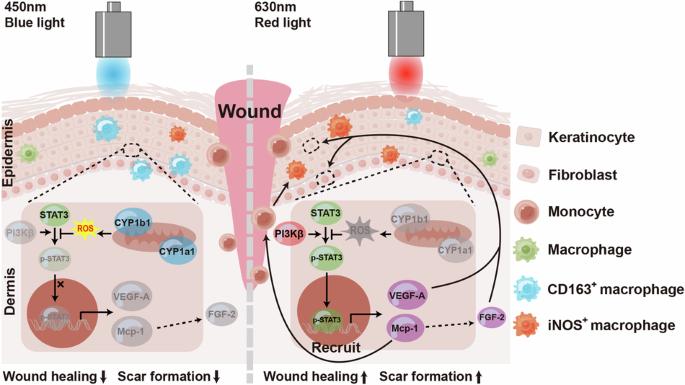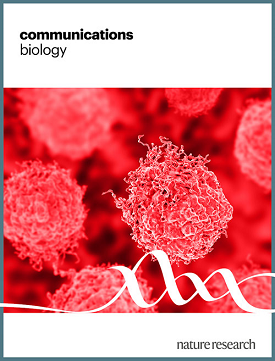可见光可通过调节 STAT3 信号加速小鼠皮肤伤口愈合并缓解疤痕形成。
IF 5.2
1区 生物学
Q1 BIOLOGY
引用次数: 0
摘要
在伤口愈合过程中,信号转导和激活转录 3(STAT3)的激活被认为是上皮细胞迁移和增殖以及建立炎症环境的关键。然而,STAT3 的过度激活会加剧疤痕的形成。在这里,我们发现 450 纳米的蓝光和 630 纳米的红光可以不同程度地调节 STAT3(p-STAT3)的磷酸化及其在角质形成细胞中的下游细胞因子。进一步的机理研究发现,红光通过激活 PI3 激酶 p110 beta(PI3Kβ)/STAT3 信号轴促进伤口愈合,而蓝光则通过调节细胞色素 c-P450 (CYT-P450)活性和活性氧(ROS)生成抑制伤口处的 p-STAT3。在小鼠疤痕模型中,先用红光再用蓝光可明显加速皮肤伤口愈合,从而减少疤痕的形成。总之,我们的研究提出了一种通过可见光调节上皮细胞 p-STAT3 的潜在策略,以解决皮肤疤痕问题,并阐明了其潜在机制。本文章由计算机程序翻译,如有差异,请以英文原文为准。

Visible light accelerates skin wound healing and alleviates scar formation in mice by adjusting STAT3 signaling
During the wound healing process, the activation of signal transducer and activator of transcription 3 (STAT3) is considered crucial for the migration and proliferation of epithelial cells, as well as for establishing the inflammatory environment. However, an excessive STAT3 activation aggravates scar formation. Here we show that 450 nm blue light and 630 nm red light can differentially regulate the phosphorylation of STAT3 (p-STAT3) and its downstream cytokines in keratinocytes. Further mechanistic studies reveal that red light promotes wound healing by activating the PI3 kinase p110 beta (PI3Kβ)/STAT3 signaling axis, while blue light inhibits p-STAT3 at the wound site by modulating cytochrome c-P450 (CYT-P450) activity and reactive oxygen species (ROS) generation. In a mouse scar model, skin wound healing can be significantly accelerated with red light followed by blue light to reduce scar formation. In summary, our study presents a potential strategy for regulating epithelial cell p-STAT3 through visible light to address skin scarring issues and elucidates the underlying mechanisms. In mouse keratinocytes, upregulation of PI3Kβ by red light promotes p-STAT3 and accelerates skin wound healing, whereas ROS induced by blue light inhibits p-STAT3 and alleviates scar formation.
求助全文
通过发布文献求助,成功后即可免费获取论文全文。
去求助
来源期刊

Communications Biology
Medicine-Medicine (miscellaneous)
CiteScore
8.60
自引率
1.70%
发文量
1233
审稿时长
13 weeks
期刊介绍:
Communications Biology is an open access journal from Nature Research publishing high-quality research, reviews and commentary in all areas of the biological sciences. Research papers published by the journal represent significant advances bringing new biological insight to a specialized area of research.
 求助内容:
求助内容: 应助结果提醒方式:
应助结果提醒方式:


